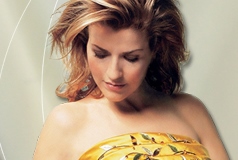
Mutter's Cincinnati Debut Supremely Musical

Cincinnati’s notoriously hard to fill Music Hall (3,516 seats) was close to a full house Sept. 28 for the Cincinnati debut of violinist Anne-Sophie Mutter, guest artist for a special gala concert by the Cincinnati Symphony Orchestra. Her listeners were richly rewarded. The regal, German-born superstar made music; it was as simple and as soul satisfying as that. In Antonin Dvořák’s Violin Concerto in A Minor and Romance in F Minor for Violin and Orchestra, she sang with the orchestra, not against it, in ways that far transcended the bounds of routine concerto performance.
Helping her bring it about was guest conductor Ignat Solzhenitsyn, as sensitive a partner as one could wish.
As the primary attraction for the event, Mutter’s performance came after intermission. She opened with a kind of anticipatory encore, Dvořák’s Romance in F Minor. One of the things that distinguished her performance was the variety of tone colors she produced, from soft-brushed and satiny to full-bodied and bright. This charmed her listeners, and there were audible sighs in the hall as she brought the Romance to an end.
She opened the Dvořák Concerto with high drama, --very high, --with two repetitions of the violin’s opening statement extending with pinpoint precision into the highest reaches of her instrument. Interaction with the orchestra was close. The podium was turned slightly askew to maximize communication between Mutter and Solzhenitsyn. Again, the quality of her tone was astonishing, particularly going into the Adagio slow movement, where she sounded almost muted before breaking into song. It was delightful to witness her interaction with the orchestra here. At one point, she literally dived beneath the principal winds to create chamber music-like textures with them.
The finale, which exudes the spirit of Dvořák’s popular Slavonic Dances, went from spritely to bold as she maintained her oneness with the orchestra, while delivering passages of the utmost virtuosity. The audience rose instantly to their feet at the end and awarded her a noisy ovation, but there was no encore.
Chief work on the first half of the concert was Elgar’s ”Enigma” Variations, which received a superlative reading by Solzhenitsyn and the CSO. Each variation was defined with the utmost precision and character. The concise Presto variation (no. 7, “Troyte”) was thrillingly incisive, while the famous “Nimrod” (no. 9) went from a whisper to a climax without a stumble. “Dorabella” (no. 10) was soft as a clutch of butterflies. Principal violist Christian Colberg and principal cellist Ilya Finkelshteyn shone in their important solos (numbers 6 and 12, respectively) and the texture of no. 13 (“Romanza”) magically conjured the shipboard noises of an ocean voyage.
The CSO strings opened with a baroque-styled Chacony by Purcell (arr. Benjamin Britten) which was marked by pure, vibrato-less tone and finely shaded dynamics.
(first published at www.ConcertoNet.com)